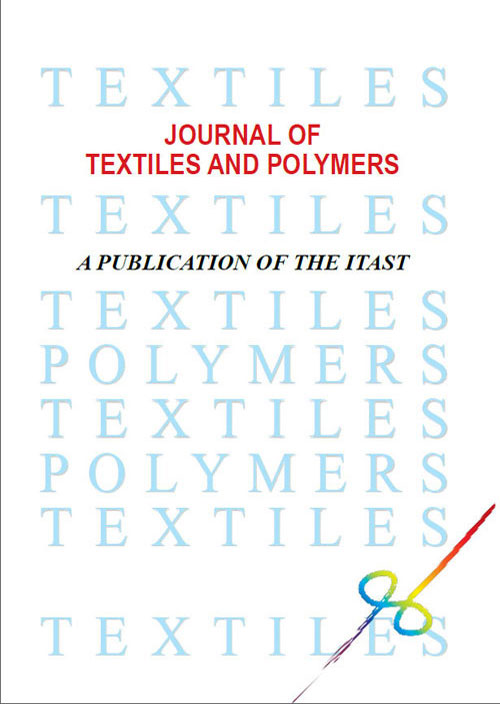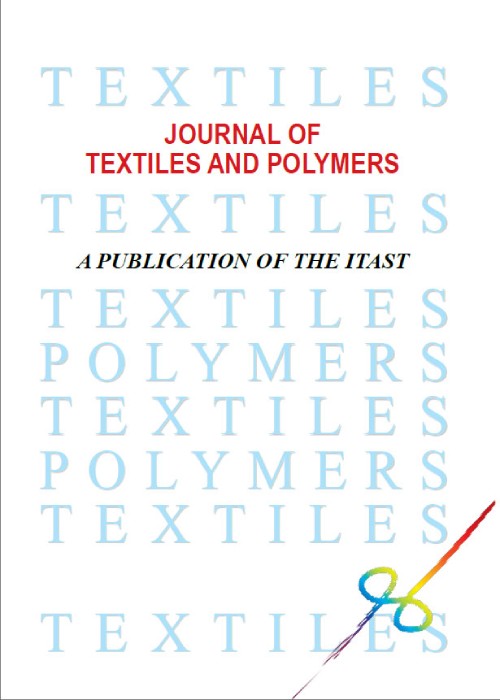فهرست مطالب

Journal of Textiles and Polymers
Volume:9 Issue: 2, Spring 2021
- تاریخ انتشار: 1400/03/29
- تعداد عناوین: 6
-
-
صفحات 71-80
-
Pages 3-14
Three-dimensional integrated woven sandwich composites (IWSCs) consist of two woven fabric facesand an integrated hollow core. The two parallel faces are bonded using pile yarns which keep a defineddistance between the top and bottom. In order to characterize the mechanical properties, three-pointbending test was performed on the IWSC sandwich composites. The results showed that by increasingthe thickness of the composite and therefore increasing the moment of inertia, the flexural strength ofthe specimens increases. The average amount of bending force increase by increasing the thickness fordifferent samples is equal to 80% to 120%. Also, by increasing the pile density, the flexural strengthin hybrid and non-hybrid specimens increases. Therefore, the maximum flexural load is obtained fromthe composites with the highest thickness and pile density. On the other hand, due to the differentarrangement of piles in the warp and weft directions, IWSC panels show different behavior in these twodirections. The values of flexural strength in the direction of the warp are higher than the direction of theweft due to the higher density of pile yarns and therefore the higher shear strength of the structure in thisdirection. In different composites, this difference is 75% to 90%. The fracture properties of the compositeunder bending load show that due to the high strength and modulus of the face-sheets compared to thecore section, the piles are more deformed and damaged and the face-sheets are not noticeably damaged.Also, the damage to the top face sheets of samples tested in the weft direction is greater than that of warp direction.
-
Pages 15-25
Reinforcement of civil structures that do not have sufficient resistance to the applied loads is of particularimportance. There are several ways to reinforce concrete structures so far. One of these methods is to usewinding technique on a concrete structure with a fabric. In this study, first, rib knitted structures with andwithout weft inserted yarn were fabricated with two types of ordinary and high tenacity polyester yarn(with a low and high modulus). Then concrete columns were made and winded using produced fabricswith and without tension. The compression test was carried out on the winded columns. The results showthat with increasing tensile modulus of the fabric (such as weft inserted rib fabric with high tenacitypolyester yarn) the compressive strength of the concrete columns increases. Accordingly, while thesample had only 7.52% weight increase and 8.75% increase in diameter compared to the control sample,the bearing capacity of the column showed an increase of 88.55% compared to the control sample. Also,the compressive strength of concrete column is increased by increasing the number of layers windedaround the concrete column.
-
Pages 27-42
Usually, the in-store design, lighting, color schemes, and other interior atmosphere could directly affectthe purchasing behavior and loyalty regarding retailing stores. The overall purpose of this work is toinvestigate these factors on customers return and interest and to study the effects of in-store factors onthe fashion retailer’s purchase intention in Tehran city. For this purpose, a sample of consumers from22 regions of Tehran city was taken, who usually visited these stores. Data were collected through awell-structured questionnaire and analyzed through confirmatory factor analysis. After designing thestatistical hypotheses, they were tested. Our findings indicate that there is a direct relationship betweensalesforce and lighting on customer return. In addition, specious stores could stimulate the customersto spend significant amount of time in apparel retailing stores. Finally, the statistical significance of theresults in the clusters was evaluated by analysis of variance (ANOVA) tests.
-
Pages 43-56
Simulating the mechanical behavior of filaments is of interest in many fields, such as designing a methodfor quality control of filaments in textile engineering. Various methods have been proposed to simulatea string structure. The mass, spring, and damper model is a conventional physics-based method that hasattracted the attention of many researchers due to its rapid simulation and greater accuracy. The purposeof this paper is to present a physical model to simulate the vibrational behavior of a monofilament. Thismodel, which is based on mass and stiffness matrices, plays an essential role in sensitivity analysis andpredicting dynamic behavior. First, a system for a realistic simulation of the transverse vibration of thestring is presented using a mass, spring and damper model. Then, the model parameters are determinedusing modal analysis and imperialist competitive algorithm. The vibration of the string was recorded atall points with a high-speed camera, and video processing is done to extract the free decays. Finally, themonofilaments are simulated and compared with their actual results to confirm the model parameters. Theresults show that the optimized model has the ability to predict the vibrational behavior of monofilamentswith an error of less than 12.3%. According to the error values, it can be stated that the results of themodal analysis were more accurate.
-
Pages 57-70
In this study the relation of physical properties of fabric and the comfort feeling of athlete during physicalactivity is considered. To this end, four single-jersey weft knitted fabrics with various fibers blends wereused to prepare sport T-shirts and then athletic comfort during wearing T-shirt and exercising in durationof 60 minutes was investigated, both subjectively and objectively. Furthermore, physical properties ofapplied fabrics including air permeability, water vapor permeability and thermal insulation propertieswere measured. Then, the relation of fabric characteristics and athletics comfort during activity wasprobed. Outcomes confirm that the increase in the body activity leads to the increment of the bodytemperature and sweating rate. Since cotton fiber absorbs and retains moisture, it keeps the skin wetduring high activity level due to the high rate of sweating. On the other hand, polyester fibers owingto the high wicking ability and quick transfer of the moisture vapor to the environment, have betterperformance. Polyester fabrics with lower stitch density and loose structure have effective performancein terms of both dissipating extra body heat and moisture vapor to the surrounding and providing athleticscomfort. The selection of proper sport wear is necessary since the level of physical activity affects thebody heat and sweating rate.
-
Pages 71-80
Today, with the advancement of technology and practical tools, the use of manual methods has becomeinefficient due to time consuming. The keys to success in clothing production are the correct use ofmodern tools, new methods of design and production management. In the present study, an attempt wasmade to provide a fast and accurate method for converting a paper pattern to a modifiable and sizabledigital pattern using image processing that is easily accessible and is not required special knowledge. Inaddition, different types of patterns including female upper body pattern, collar and collar hem, sleevesand pants were prepared. In order to express the results, six levels are considered for the average errorobtained from sizing, which are high level (error less than 0.1 cm), relatively high (error between 0.1 cmto 0.4 cm), medium (error between 0.4 cm to 0.6 cm), relatively medium (error between 0.6 cm to 0.8 cm),relatively low (error between 0.8 to 1 cm) and low (error greater than 1 cm). After sizing and evaluatingthe measured errors, it was concluded that the average total errors in the proposed method to increase anddecrease the sizes are 0.33 and 0.266 cm, respectively.


